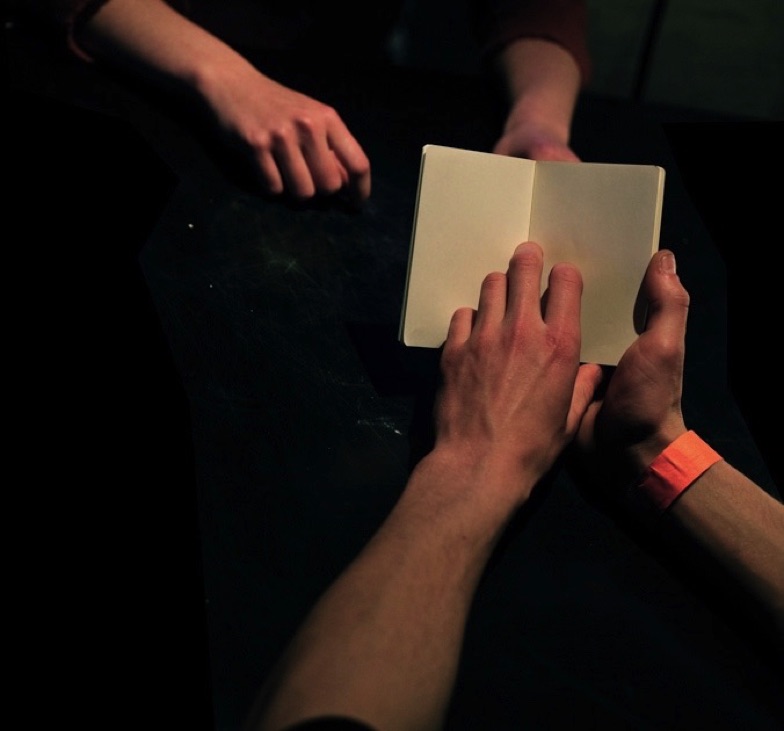
as Rotozaza (Ant Hampton & Silvia Mercuriali) >
Etiquette - 2007
by Ant Hampton (click for website & links to all work)
Time for Answers - with Christophe Meierhans - 2020
Not to Scale - with Tim Etchells - 2020
The Thing (Automatic Workshop) - with Christophe Meierhans - 2017
Crazy But True - 2016/17
The Extra People - 2015
Someone Else - 2015
Lest We See Where We Are - with Tim Etchells - 2013 / 2014
Cue China (Elsewhere, Offshore) - 2012
This Is Not My Voice Speaking with Britt Hatzius - 2011
OK OK with Gert-Jan Stam - 2011
Hello For Dummies, with Glen Neath - 2011 (via The Bench, 2010)
The Quiet Volume, with Tim Etchells - 2010
GuruGuru with Koyama & Khroustaliov - 2009
by Silvia Mercuriali (click for website & links to all work)
Swimming Home 2020
Macondo 2017
I hear U C me - with Tommaso Perego - 2015
Le grand Voyage - an il pixel rosso production - 2014
Rebels and Rubble - an il pixel rosso production - 2013
The Great Spavaldos - an il pixel rosso production - 2012
The Eye, a Fuel Theatre production
with Tommaso Perego & Dominic Ffytche - 2012
And the Birds fell from the Sky, an Il Pixel Rosso production - 2010
Wondermart, with Matt Rudkin and Tommaso Perego - 2009
Autoteatro is a term coined by Ant Hampton and Silvia Mercuriali in 2007 for Rotozaza's 'Etiquette' to distinguish it from other audio-led performance at the time which was often for single participants.
In Autoteatro, audience members perform the piece themselves, for each other. Participants are given instruction via audio, visual cues or text for what to do or say. By simply following these instructions an event begins to unfold. One moment you may be watching or witnessing the other(s) performing, not unlike a normal audience experience. The next you may be doing or saying something which in turn creates a moment of performance to be witnessed by the other(s). Not to be confused with gaming (or ‘game show’-like improvisation), Autoteatro does not require audience members to be clever or inventive, neither does it necessarily set up instances of competition.
It’s also possible to define it as:
- functioning automatically: once started, there are no actors or other human involvment or labour during the work other than the participants engagement. An Autoteatro work exists as a fixed, often pre-recorded 'trigger' for a performance embodied only by those taking part. As well as sometimes allowing for Showing Without Going, being automated means it's usually possible to run the work on loop for large audiences over longer periods, and to multiply the number of simultaneous performances in different places.
- having no audience beyond the participants themselves. This creates a levelling of what would otherwise be unequal power dynamics: there's no director or rehearsed actor who knows how things 'should be going'; no-one sitting in the dark making judgements about those performing. You know that the other person or people are discovering everything with you. Sharing risk often allows us to take more risk.
A brief history of Autoteatro...
For Rotozaza's third work in 1999, Ant Hampton and Sam Britton created a show called BLOKE for a non-actor friend they wanted to see on stage. To get around the problem of him worrying about the job - or responsibility - of performing, they proposed to him to skip any preparation or rehearsals if he'd agree to follow prompts live in front of an audience. 'Just keep trying, and don't worry if you mess it up'. Responding to a script of pre-recorded instructions, their friend gave a performance suffused with a kind of honesty they’d rarely seen before on stage, embracing error and clumsiness, and transforming the audience from passive specatator to a more active role; aware they’re discovering everything at the same time as the person in front of them.
In 2003, Ant created a second piece using instructions to unrehearsed guest performers (Romcom, with Glen Neath), and shortly afterwards initiated a research project into this way of creating performance. Following that, Ant and Silvia (as Rotozaza) created four works (Doublethink, Ooff, Punta Dois, Five in the Morning), which applied the strategy in different ways (more info here).
The idea for Etiquette came soon after BLOKE and work began on it in 2001, but it wasn't until 2007 that the piece was finally able to develop. After 8 years of the guest performers in their shows (amateurs, professionals and total first-timers) often telling them how fascinating an experience it was to let themselves be guided like this within a performative situation, Ant and Silvia finally engineered Etiquette to be the means by which an audience could experience this themselves.
Since 2009 Ant and Silvia have worked independently to create, alongside other projects, the Autoteatro works listed above.
photo candice cellier